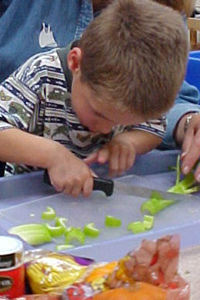Increasing Your Blind or Low-Vision Preschooler’s Independence in the Kitchen and at Meals
Now that your child may begin eating snacks with other children in preschool or going out to eat with you in restaurants, they need to know how to feed themselves and eat neatly using regular utensils. This is also a good time to introduce simple ways of preparing food to develop an understanding how meals are prepared and get to the table.
Learning Table Skills
Because your child may not be motivated to learn to eat “like a big kid” by observing and imitating how you and other family members eat, your child may need more time and focused attention than siblings or friends to learn table skills.
- Put your child’s bowl, plate, cup, and utensils in the same place so your child can always find them. Tell your child where each item is on the plate.
- It’s helpful to use hand-under-hand technique when you demonstrate how to use a knife for spreading or a fork. Try working from behind your child so your hands move in the same direction.
- Show your child how to use a piece of bread or knife to get food on a fork or stab it. This is more acceptable when out in public than using fingers. This is a good idea to get used to doing that at home.
- If your child isn’t eager to try something new, introduce the skill at the beginning of the meal when your child is most hungry. Start the meal by putting just a few pieces of meat on a plate and encourage your child to eat it all with their fork before serving the mashed potatoes you know they enjoy.
- Show your child how to open containers such as juice, cereal boxes, and milk cartons. Once your child starts grade school, they’ll need to know how to do that in order to eat snack or lunch by independently.
- If your child has low vision, look for bowls, cups, and utensils that have high contrast. It’s easier to scoop macaroni and cheese from a black bowl than a yellow one. The black surface provides a stronger contrast to help your child see what’s in the bowl.
Helping to Prepare Simple Snacks and Meals

Now that your child will soon be in kindergarten, you may want to find ways to involve them in preparing simple meals or snacks. Not only does this provide a chance to learn new skills and concepts—such as cooperating, pouring, and measuring—but it also helps build an understanding where food comes from and the transformations it undergoes from its precooked state to the finished meal.
Tips for Good Kitchen Habits
- Pick a cabinet or drawer where your child can keep things needed for “cooking.” These tools may include plastic plates, cups, and bowls; a medium size mixing bowl; a wooden spoon; and measuring cups and spoons with high-contrast colors or tactile markings.
- You might want to suggest making a book of recipes with your child—simple things such as peanut butter and jelly or melted cheese sandwiches in the toaster oven, popcorn in the microwave, or hard boiled eggs cooked on top of the stove for egg salad. If your child has some vision, the recipes could be written in large print or in braille.
- Show your child how to organize their workspace. A tray with a raised edge may be helpful so things don’t roll away.
- Use the hand-under-hand technique when showing your child how to do something—for example, breaking an egg and pouring.
- Involve your child in all aspects of the task. This might include gathering the things needed to make a snack and doing the dishes afterward.
- At this stage, your child will be using knives that aren’t sharp or pointed. Your child must understand that knives are sharp and can hurt you if not handled carefully.
- All young children have to learn oven and stove top safety. When the oven is cold, let your child explore it. Show your child how to open it, where the racks are, and how to close the oven door. Let your child feel the buttons or knobs and explain what each one does. Do the same thing with the stove top. Be sure your child understands that a stove isn’t something to be played with. Point out that when the oven is on, you’ll feel the warmth when near it and shouldn’t go closer.
Teaching your child how to eat and start preparing their own snacks teaches about more than just food. It opens up new experiences and ideas and helps provide steps toward independence.